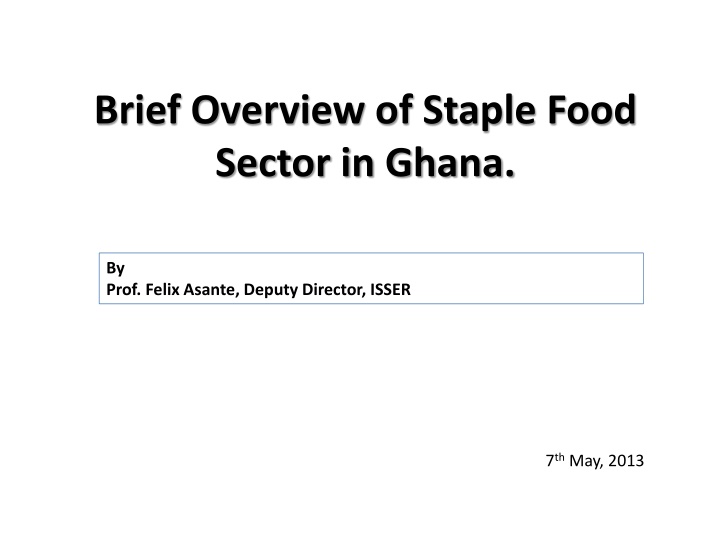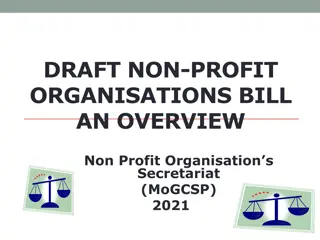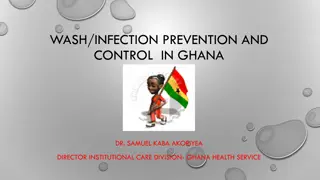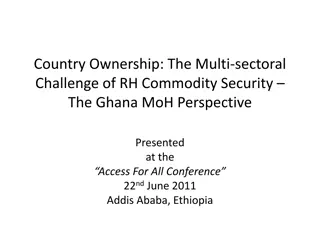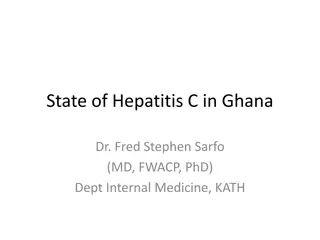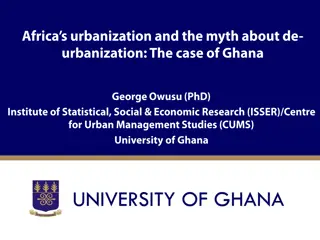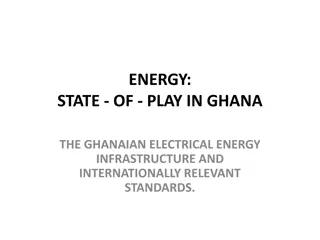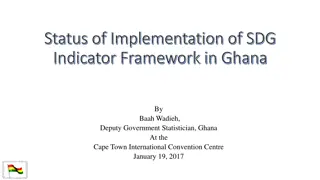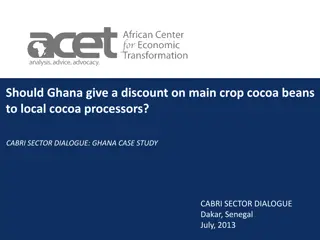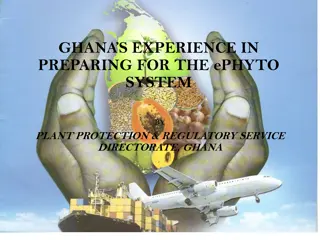Brief Overview of Staple Food Sector in Ghana
Small-scale rural farmers dominate Ghana's staple food sector, with prices fluctuating based on market proximity and time of year. Various reforms have been implemented to modernize and enhance agricultural productivity in the country.
Download Presentation

Please find below an Image/Link to download the presentation.
The content on the website is provided AS IS for your information and personal use only. It may not be sold, licensed, or shared on other websites without obtaining consent from the author.If you encounter any issues during the download, it is possible that the publisher has removed the file from their server.
You are allowed to download the files provided on this website for personal or commercial use, subject to the condition that they are used lawfully. All files are the property of their respective owners.
The content on the website is provided AS IS for your information and personal use only. It may not be sold, licensed, or shared on other websites without obtaining consent from the author.
E N D
Presentation Transcript
Brief Overview of Staple Food Sector in Ghana. By Prof. Felix Asante, Deputy Director, ISSER 7th May, 2013
Structure of the Market and Distribution Network Small scale rural farmers dominate the staple food sector in Ghana for household food security and income. Most of the staples foods in Ghana are gathered in small quantities and aggregated by itinerant traders. Wholesale prices for staple foods ranges and depend on proximity to regional markets and time of the year Transport cost and nature of roads also translate into the wholesale price also.
Structure of the Market and Distribution Network cont d However, there are distinct months where the peak and trough prices of staples are predictable For example, maize prices are generally highest in July and lowest January and February. The staple foods are sold predominantly at the domestic market throughout the country with occasional formal and informal exports in smaller quantities.
Structure of the Market and Distribution Network cont d Figure 1: General Distribution Network of Staple Foods. Producers Frontline Assemblers Itinerant Wholesalers Resident Wholesalers Retailers [Market Traders and Hawkers] Consumers
Reforms Undertaken Agricultural modernisation agenda in the 10 years development plan (1951-1964) Agricultural Development Corporation State Farms Workers Brigade and Farmers Co-operative Operation Feed Yourself and Feed Your Industry (1972-1974)
Reforms Undertaken contd Economic Recovery Programme (ERP)/Structural Adjustment Programme (SAP) (1983-2000) Agricultural Services Rehabilitation Project (ASRP) (1987-90) Rural Finance Project (RFP) (1989-92) Medium Term Agricultural Development Programme (MTADP), 1990 Agricultural Diversification Project (ADP) (1991-99), National Agricultural Research Project (NARP) (1991-99), National Agricultural Extension Project (NAEP) (1992-2000), Agricultural Sector Adjustment Credit (ASAC) (1992-99), Agricultural Sector Investment Project (ASIP) (1994-2000) Accelerated Agricultural Development Strategy (AAGDS), 1996 Agricultural Services Sub-sector Investment Project (AgSSIP), 2002
Reforms Undertaken contd Comprehensive African Agricultural Development Program (CAADP), 2003 Food and Agriculture Sector Development Policy (FASDEP I&II), (2002-2008) Medium Term Agriculture Sector Investment Plan (METASIP), (2011-2015) Ghana Shared Growth and Development Agenda (GSGDA), (2010-2013) Fertilizer Subsidy Programme Agricultural Mechanisation Programme Block Farm and Youth in Agricultural Programme National Buffer Stock Company (NAFCO)
Performance of Current Programmes 1. Fertilizer Subsidy Programme There has been increased fertilizer usage in terms of area and per unit application. 2. Agricultural Mechanisation Programme There has been increased access by farmers around project location to mechanisation services which has also resulted in increase acreages. 3. Block Farm and Youth in Agricultural Programme Here has been easy access to low cost input credit and mechanisation services. Contrarily to the concept of the programme, youth (18-35 years) participation has been low. 4. National Buffer Stock Company (NAFCO) There has been relative stabilisation of maize price since 2010. (Benin et al., 2011)
Performance of Staple Sector Production and productivity of some staples saw an increase whiles others decreased in 2011. Although maize and rice witnessed a positive rate of growth in area cultivated (3.2% and 8.97% respectively), in 2010/2011 cropping seasons, the rate of growth in production and productivity were negative.
Performance of Staple Sector contd Table 1: Area Cultivated of Selected Staples, 2006-2011 Staple Area (000 hectares) 2009 Roots, Tubers &plantain 2006 2007 2008 2010 2011 %Change 2010/2011 Cassava 790 801 840 886 878 904 2.86 Yam 325 324 348 379 385 404 5.03 Cocoyam 260 258 252 225 205 206 0.48 Plantain 299 305 312 324 328 339 3.31 Cereals Maize 793 790 846 954 992 1,023 3.20 Sorghum 320 208 276 267 253 244 -3.32 Millet 200 162 182 186 177 180 2.10 Rice (Milled) 125 109 133 162 181 197 8.97 Source: Ministry of Food and Agriculture, Accra, 2011.
Performance of Staple Sector contd Table 2: Output of Selected Staples, 2006-2011. Staple Output (000 tonnes) Roots, Tubers &plantain Cassava 2006 2007 2008 2009 2010 2011 %Change 2010/2011 9,638 10,218 11,351 12,260 13,550 14,703 8.51 Yam 4,288 4,376 4,895 5,778 5,960 6,285 5.44 Cocoyam 1,660 1,690 1,688 1,504 1,355 1,265 -6.65 Plantain 2,900 3,234 3,338 3,563 3,538 3,641 2.91 Cereals Maize 1,188 1,220 1,470 1,620 1,872 1,684 -10.02 Sorghum 315 155 331 315 324 288 -11.12 Millet 165 113 194 246 218 186 -14.84 Rice (Milled) 250 185 302 391 492 464 -5.62 Source: Ministry of Food and Agriculture, Accra, 2011
Performance of Staple Sector contd Table 3: Yield per Hectare of Selected Staples, 2006-2011 Staple Roots, Tubers &plantain Yield (tonnes per hectares) 2008 2009 2006 2007 2010 2011 %Change 2010/2011 Cassava Yam Cocoyam Plantain Cereals Maize Sorghum Millet Rice (Milled) 12.2 13.2 6.4 9.7 12.8 13.5 6.6 10.6 13.51 14.08 6.7 10.7 13.8 15.3 6.7 10.9 15.43 15.48 6.6 10.79 16.27 15.54 6.13 10.75 5.49 0.39 -7.09 -0.39 1.5 1 0.8 2 1.5 0.7 0.7 1.7 1.74 1.2 1.06 2.72 1.7 1.3 1.3 2.4 1.89 1.28 1.24 2.71 1.65 1.18 1.03 2.35 -12.80 -8.07 -16.60 -13.39 Source: Ministry of Food and Agriculture, Accra, 2011.
Performance of Staple Sector contd There has been general decline in total domestic production There is however ascendency of estimated national consumption However, the country continued to run surplus in most of her staples. Rich sill encounters deficit in production.
Performance of Staple Sector contd Table 4: Domestic Staple Food Supply and Demand Position (2010/2011)( 000MT) Staple Total Domestic Production Production Available for Human Consumption 2010 Estimated National Consumption Deficit/Surplus Roots, Tubers &plantain 2010 2011 2011 2010 2011 2010 2011 Cassava 13,550 14,703 9,485 9,969 3,703 3,884 5,781.90 6,084.90 Yam 5,960 6,285 4,768 5,036 3,028 3,175 1,740.90 1,861.40 Cocoyam Plantain Cereals Maize Sorghum Millet Rice (Milled) 1,355 3,538 1,265 3,641 1,287 3,007 1,235 3,077 969 2,054 1,016 2,154 318.3 953.2 218.7 922.9 1,872 324 218 492 1,684 288 186 464 1,310 282 190 257 1,179 250 160 242 1,061 121 121 581 1,113 127 127 610 249.4 161.1 69.4 -324.7 66.3 122.7 33 -367.4 Source: Ministry of Food and Agriculture, Accra, 2011.
Public and Private Participation in the Sector The staple food sector is free and open to all economic agents in the economy. Notable public agents are: MoFA and Programme Directorates, CSIR, NAFCO, Agricultural training institutions, and NGOs. Notable private agents are: Farmers, marketing companies/individuals, input dealers, processing companies and food joints. The public agents busy themselves with controlling, technological dissemination and raw material improvements The private agent are much interested in actual production to satisfy consumers and for income.
Public and Private Participation in the Sector cont d Public and private agents participate at various levels and degree along the staple foods value chain. For instance, NAFCO have special arrangements with Licensed Buying Companies.
Consumer and Producer Concerns at the Market Post-Harvest handling and storage at farm gate. Pest and foreign material infestation Handling at market and warehouse Rodent attacks Moisture control
Private Association and their Nature of Engagement There are a number of farmer base organisations (FBO s) in the staple food sector Their concepts are base on the cooperative system. One known association is the N arziki Farmers Association an initiative of Wienco (Ghana) Limited. support small medium holder farmers to adopt good agricultural practices and understand agribusiness. Facilitate better access to markets
The end The end Thank You
